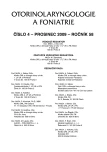The Benefit of Binaural Amplification for the Speech Intelligibility - The Influence of the Degree of the Hearing Loss
Authors:
R. Havlík
Authors‘ workplace:
AUDIO-Fon centr s. r. o., Brno
přednosta doc. MUDr. M. Lejska, CSc.
Published in:
Otorinolaryngol Foniatr, 58, 2009, No. 4, pp. 204-210.
Category:
Original Article
Overview
The paper analyzes the quantitative benefit of binaural amplification in comparison to monaural one for the speech intelligibility on the background noise in precisely defined SNR (signal-to-noise ratios). 189 hearing impaired persons who decided to use a hearing aid on both ears have been examined. They were divided into 3 groups according to the degree of their hearing loss (40-49 dB HL, 50-59 dB HL, 60-69 dB HL). The author evaluated the benefit within each group and the mutual comparisons. The results indicate that the speech intelligibility improvement occurs especially in the negative values of SNR and the global benefit of the second hearing instrument is directly related to the severity of the hearing loss.
Key words:
binaural amplification, monaural amplification, SNR, hearing loss, acoustic signal, audimetric curve.
Sources
1. Brugel, F. J., Schorn, K.: Die In-situ-Messung als Notwendiger Bestandteil der Hörgeräteanpassung. Laryngorhinootologie, 70, 1991, 11, s. 616-619.
2. Brugel, F. J., Schorn, K., Fastl, H.: Eie Einfluss der Zusatzbohrung im Ohrpassstück auf die Sprachdiscrimination im Störgeräuch. HNO, 39, 1991, 9, s. 356-361.
3. Cox, R., DeChicchis, A. R., Wark, D. J.: Demonstration of binaural advantage in audiometric test rooms. Ear Hear, 1981, 2, s. 194-201.
4. De Jonge, R.: Selecting and verifying hearing aid fittings for symmetrical hearing loss, in Valente, M.: Strategies for selecting and verifying hearing aid fittings. New York, Thieme Medical Publishers, INC, 1994, s. 180-206.
5. Dlouhá, O., Novák, A., Vokřál, J.: Česká slovní audiometrie – vývoj nových testů. Otorinolaryng. a Foniat. /Prague/, 57, 2008, 4, s. 195-200.
6. Gao, Y., Huang, T., Haton, J. P.: Central auditory model for spectral processing. 2, 1993, s. 1993, s. 704–707.
7. Havlík, R.: Vliv individuální ušní vložky na akustický signál sluchadla. Philips, 1998.
8. Havlík, R.: Binaurální slyšení: známá i méně známá fakta o sluchové funkci. Philips, 2000
9. Havlík, R., Weberová, P., Lejska, M.: Binaurální korekce sluchové vady. Otorinolaryng. a Foniat. /Prague/, 53, 2004. 1, s. 20-24.
10. Havlík, R.: Sluchadlová propedeutika. MIKADAPRESS, Brno, 2007.
11. Hawkins, D. B., Yacullo, W.: Signal-to-noise ratio advantage of binaural hearing aids and directional microphones under different levels of reverberation. J. Speech Hear Dis., 49, 1984, s. 278-286.
12. Keidser, G., Katsch, R., Dillon, H, Grant, F.: Relative loudness of low - and high-frequency bands of speech-shaped babble, including the influence of bandwidth and input level. The Journal of the Acoustical Society of America, 111, 2002, 2, s. 669-671.
13. Keller, F., Freiburg, B.: Akustische Eigenschaften des Ohrpassstückes. Zusammenstellung, 1982.
14. Kristjansson, T., Frey, B., Deng, L., Acero, A.: Towards non-stationary model-based noise adaptation for largevocabulary speech recognition. Acoustics, Speech, and Signal Processing, 1, 2001, s. 337-340.
15. Li, F. F., Cox, T. J.: A neural network model for speech intelligibility quantification. Applied Soft Computing, 7, 2007, 1, s. 145-155.
16. Markides, A.: Binaural hearing aids. London, Academic Press, 1977.
17. Nabelek, A. K.: The effects of room acoustics on speech perception through hearing aids by normal-hearing and hearing-impaired listeners, in Studebaker G. A., Hochberg, I: Acoustical factors affecting hearing aid performance. Baltimore, University Press, 1980, s. 25-46.
18. Novák, A.: Korekce sluchových vad sluchadly. Unitisk, Praha, 1995.
19. Rao, M. D., Letowski, T.: Callsign Aquisition Test (CAT): speech intelligibility in noise. Ear Hear, 27, 2006 2, s. 120-128.
20. Sandlin, R. E.: Texbook of hearing aid amplification - technical and clinical considerations. Singular Publishing Group, Thomson Learning, San Diego, 2000.
21. Seeman, M. a kol.: Česká slovní audiometrie. SZN, Praha, 1960.
22. Shu, H.: A speech test with speech-babble noise: Relation between frequency range of noise and word intelligibility. Japanese Journal of Special Education, 37, 2000, 4, s. 49-59.
23. Stach, B. A.: Clinical audiology: an introduction. Singular Publishing Group, INC, San Diego, 1998.
24. Wertz, D. M. S., Hall, J. W., Davis, W.: Auditory processing disorders: Management approaches past to present. Seminars in Hearing, 23, 2002, 4, s. 277-285.
25. Yao, K., Paliwal, K. K., Nakamur, S.: Noise adaptive speech recognition based on sequential noise parameter estimation. Speech Communication, 42, 2004, 1, s. 5-23.
Labels
Audiology Paediatric ENT ENT (Otorhinolaryngology)Article was published in
Otorhinolaryngology and Phoniatrics

2009 Issue 4
Most read in this issue
- Lingua Geographica
- Extensive Cholesteatoma in the Mastoid Process
- Duplex Ultrasound in Preoperative Examination on Tumors of Major Salivary Glands I (Theoretical Background)
- Indications and Importance of Sentinel Lymph Node Biopsy in Head and Neck Tumors
